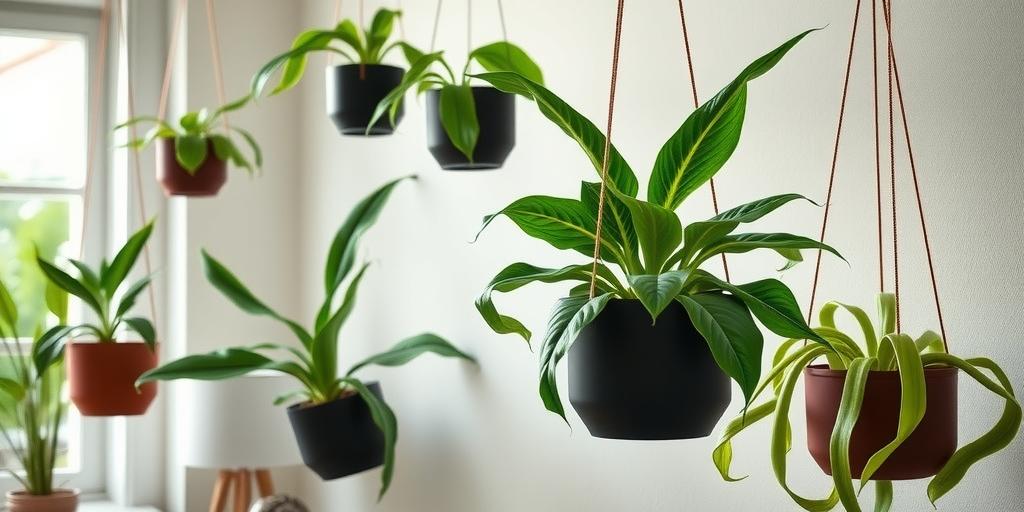
7 Safe Low Light Hanging Plants to Brighten Up Your Home (2025)
Discover 7 safe, low-light hanging plants perfect for your home! These easy-care, pet-friendly options thrive in dim spaces while adding greenery and charm.
Introduction
Did you know that indoor plants can boost your mood and purify the air—even in low light? If your home lacks bright sunlight, don’t worry! Many stunning hanging plants flourish in shady corners, bringing life to any space. Whether you’re a busy plant parent or a beginner, these safe, low-light hanging plants are perfect for apartments, offices, or cozy nooks. Let’s explore the best options that are non-toxic, easy to maintain, and ideal for dim environments!
Spider Plant (Chlorophytum comosum)
Why It’s Great for Low Light
The Spider Plant is a superstar when it comes to thriving in low-light conditions. It adapts effortlessly to indirect sunlight and even does well under fluorescent lighting, making it perfect for offices or dimly lit apartments. While it prefers bright, indirect light, it won’t throw a fit if it’s placed in a shadier spot—just expect slower growth.
Safety for Pets
Good news for pet owners: Spider Plants are completely non-toxic to cats and dogs. If your furry friend takes a nibble, there’s no need to panic. That said, some cats are drawn to the long, dangling leaves, so you might want to hang it high to avoid constant feline interference!
Care Tips
This plant is forgiving when it comes to watering—just let the soil dry out between waterings. Overwatering can lead to root rot, so err on the side of underwatering. Spider Plants look fantastic in hanging baskets, where their arching leaves and “spiderettes” (baby plants) can cascade down beautifully.
Bonus: Easy Propagation
One of the coolest things about Spider Plants is how easily they propagate. Those little offshoots (spiderettes) can be snipped off and rooted in water or soil, giving you endless new plants to share or expand your collection.
Pothos (Epipremnum aureum)
Why It’s Great for Low Light
Pothos is practically indestructible, which is why it’s a favorite among beginner plant parents. It grows well in low light, though it may lose some of its variegation in darker spots. If you want more vibrant leaves, a bit of indirect light helps, but it won’t sulk in shade.
Safety for Pets
While Pothos is a hardy plant, it’s mildly toxic to pets if ingested. The calcium oxalate crystals in its leaves can cause irritation, so if you have curious cats or dogs, keep it out of reach—maybe on a high shelf or in a hanging planter.
Care Tips
Pothos prefers to dry out between waterings. Overwatering is its biggest enemy, so wait until the top inch of soil is dry before giving it a drink. Its trailing vines make it perfect for macramé hangers or shelves where it can drape elegantly.
Varieties to Try
If you love color, Pothos comes in several stunning varieties:
-
Golden Pothos – Classic green leaves with golden-yellow streaks.
-
Marble Queen – Creamy white and green marbled foliage.
-
Neon Pothos – Bright, lime-green leaves that pop in any space.
Heartleaf Philodendron (Philodendron hederaceum)
Why It’s Great for Low Light
This plant is a low-light champion, thriving in indirect sunlight with minimal fuss. It’s a fast grower, even in less-than-ideal lighting, making it a great choice for darker corners that need some greenery.
Safety for Pets
Unfortunately, Heartleaf Philodendron is toxic to pets due to calcium oxalate crystals. If you have cats or dogs, consider placing it in a hanging pot where they can’t reach it.
Care Tips
Like Pothos, this plant prefers its soil to dry out between waterings. Overwatering can lead to yellow leaves, so stick to a “less is more” approach. Its vining habit makes it perfect for hanging planters or training up a small trellis for a lush, jungle-like effect.
Staghorn Fern (Platycerium bifurcatum)
Why It’s Great for Low Light
Staghorn Ferns love filtered light, making them ideal for rooms with north-facing windows or shaded patios. Their unique, antler-shaped fronds add a touch of wild elegance to any space.
Safety for Pets
Great news—Staghorn Ferns are non-toxic to pets! So if your cat or dog gets curious, there’s no need to worry.
Care Tips
Unlike most houseplants, Staghorn Ferns are epiphytes, meaning they naturally grow on trees rather than in soil. They thrive when mounted on wooden boards or placed in hanging baskets with a well-draining medium like sphagnum moss. Mist them regularly to mimic their humid natural habitat.
String of Hearts (Ceropegia woodii)
Why It’s Great for Low Light
This delicate trailing plant does best in bright, indirect light but can tolerate lower light conditions. In shadier spots, its growth may slow, and the leaves might lose some of their silvery variegation, but it will still survive.
Safety for Pets
String of Hearts is safe for pets, so you can let it cascade freely without worrying about your furry friends.
Care Tips
This succulent-like plant prefers infrequent watering—let the soil dry out completely between waterings to prevent rot. Its long, trailing stems with heart-shaped leaves look stunning in hanging planters or on high shelves where they can spill over gracefully.
Bird’s Nest Fern (Asplenium nidus)
Why It’s Great for Low Light
Bird’s Nest Ferns thrive in low to medium indirect light and love humidity, making them perfect for bathrooms or kitchens. Their wavy, bright green fronds add a lush, tropical feel to any room.
Safety for Pets
Another pet-friendly option! This fern is non-toxic, so it’s safe to keep around cats and dogs.
Care Tips
Keep the soil consistently moist but not soggy—think damp, not drenched. They appreciate higher humidity, so misting or placing them near a humidifier can help keep them happy. Avoid direct sunlight, which can scorch their delicate leaves.
Peperomia (Peperomia spp.)
Why It’s Great for Low Light
Peperomias are compact, adaptable plants that do well in shady spots. With over 1,000 species, there’s a Peperomia for every taste—from the ripple-textured Peperomia caperata to the watermelon-patterned Peperomia argyreia.
Safety for Pets
All Peperomia varieties are non-toxic, making them a worry-free choice for pet owners.
Care Tips
Water only when the top layer of soil feels dry. Overwatering is a common issue, so less is more. Their small size makes them ideal for tiny hanging planters or as part of a mixed terrarium. Plus, their thick, sometimes colorful leaves add great texture to any plant collection.
Conclusion
Who says you need bright sunlight to enjoy lush greenery? These 7 safe, low-light hanging plants are perfect for adding life to dim corners while being easy to care for. Whether you prefer the cascading vines of a Pothos or the unique look of a Staghorn Fern, there’s an option for every home. Ready to transform your space? Pick your favorite and start hanging!
